How Ro Repair Caps On Post Tension Slab
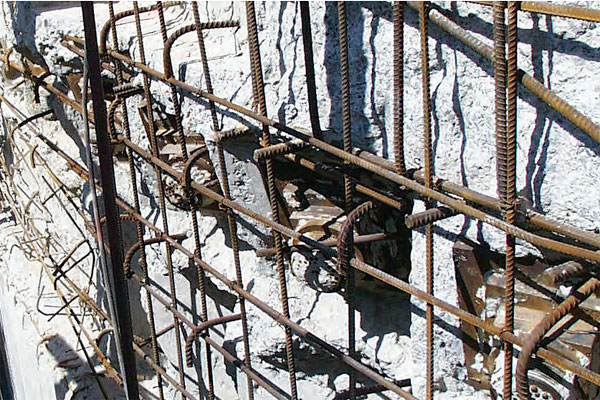
Post-tensioning can exist explained equally the method of reinforcing concrete or other materials with loftier-strength steel strands or bars, typically referred to as tendons. Their applications include commercial buildings, residential buildings, parking structures, slabs-on-ground, bridges, sports stadiums, rock and soil anchors, and h2o-tanks. Post-tensioning tendons, which are prestressing steel cables within plastic ducts or sleeves, are positioned in the forms before the concrete is placed. Afterward, once the concrete has gained strength but before the service loads are practical, the cables are pulled tight, or tensioned, and anchored against the outer edges of the concrete.
Elements of the post-tensioning system for repair and rehabilitation
The basic element of a post-tensioning organisation is called a tendon. A post-tensioning tendon is made upwards of one or more pieces of prestressing steel, coated with a protective coating, and housed inside of a duct or sheathing. A tendon will have anchors on each end to transmit the forces into the structure. Long tendons may as well accept intermediate anchors along their length.
Anchorages are another disquisitional element. Ballast Head is an important role of the mail service-tensioning system. It works in tandem with the Wedge that holds the individual tensile element. The prestressing load is then transferred to the Begetting Plate. For some modest tendon sizes, this prestressing force can be transferred directly to the structure without the demand for Begetting Plate. In the example of some mono anchorage organization, the Wedge will hold an individual tensile element direct to the Bearing Plate.
Internal bonded tendons – where ane or more strands are inserted into a metal or plastic duct that is embedded in the physical. By filling the duct with special grout, the tendon is 'bonded' with the surrounding concrete. Internal bonded tendons are installed before concrete is poured and become locked in concrete. This approach is often used for bridges and heavily loaded beams in buildings – flat internal systems are also an excellent choice for thin slabs.
Internal unbonded tendons – where the prestressing steel is not bonded to the concrete that surrounds it, except at the anchorages. They are used in slabs and slabs-on-ground for buildings and parking structures just likewise more and more in infrastructure projects.
External unbonded tendons – these are installed on the outer surface of physical structures. This type of postal service-tensioning allows access for maintenance and replacement, this is therefore the solution of choice for bridge enhancements and refurbishments.
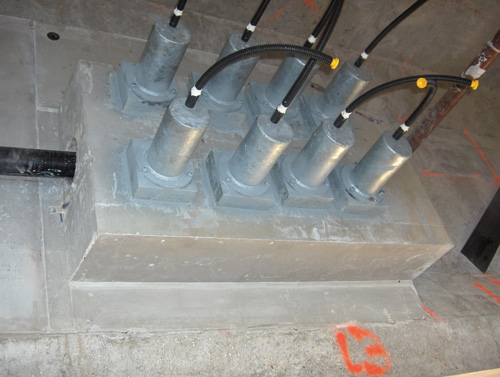
Another important chemical element is the hydraulic tension jack. Tension is applied to prestressing steel by using a hydraulic stressing jack. The jack bears confronting one of the anchors that are embedded in the concrete and pulls the steel to a predetermined strength. As the tensioning is occurring, the steel is being elongated, and the physical or masonry chemical element is beingness compressed.
In unbonded construction, the plastic sheathing acts as a bond breaker between the physical and the prestressing strands. Information technology also protects confronting damage by mechanical handling and serves as a barrier that prevents moisture and chemicals from reaching the strand.
Begetting Plate is a very important element in a mail-tensioning arrangement. It serves the purpose of transferring prestressing force derived from the tendon to the concrete. And it is precisely in this, that explains what we desire to achieve in prestressed physical structures, and thus nosotros take special interest in the Begetting Plate.
Advantages of the post-tensioning system for repair and rehabilitation
There are post-tensioning applications in almost all facets of construction. In building construction, post-tensioning allows longer articulate spans, thinner slabs, fewer beams and more slender, dramatic elements. Thinner slabs mean less concrete is required. As well, it means a lower overall building peak for the same floor-to-floor height. Postal service Tensioning can thus allow a significant reduction in building weight versus a conventional concrete building with the aforementioned number of floors. This reduces the foundation load and tin can be a major advantage in seismic areas.
Lower building height can also translate to considerable savings in mechanical systems and façade costs. Another advantage of mail service-tensioning is that beams and slabs can be continuous, i.e. a single axle can run continuously from one stop of the building to the other. Structurally, this is much more than efficient than having a axle that only goes from one cavalcade to the adjacent.
Mail service-tensioning is the organisation of choice for parking structures since it allows a high caste of flexibility in the column layout, span lengths and ramp configurations. Post-tensioned parking garages tin be either stand-alone structures or i or more floors in an office or residential building. In areas where there are expansive clays or soils with depression begetting capacity, post-tensioned slabs-on-ground and mat foundations reduce problems with cracking and differential settlement.
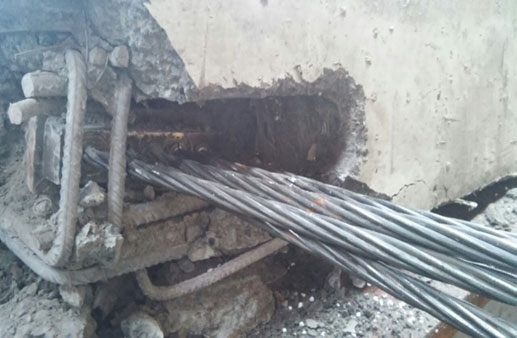
Post-tensioning allows bridges to be built to very demanding geometry requirements, including circuitous curves, variable superelevation and significant class changes. Post-tensioning also allows extremely long-span bridges to exist constructed without the apply of temporary intermediate supports.
In stadiums, post-tensioning allows long articulate spans and very creative architecture. Mail service-tensioned stone and soil anchors are used in tunneling and slope stabilization and as tie-backs for excavations. Post-tensioning tin can as well exist used to produce nearly crack-costless concrete for water-tanks.
Installation of a postal service-tension system for repair and rehabilitation
Expert advice and supervision are important for postal service-tensioning works. The sequence of work too plays a central role.
- Designing the shape of the PT layout and specifying the right organization is a vital stage in the process
- Work on applying the post-tensioning system tin can begin after whatever formwork or lesser reinforcement has been installed.
- Typically, for a bonded arrangement, ducting will be laid out beginning, then strands will exist installed with the help of a strand-pushing machine and end anchorages will exist placed
- Cables are arranged as indicated by the engineer and chaired to run through the eye of the slab.
- Commercial foundations volition accept much more steel. Tendons tin be hands routed around obstructions.
- The physical placement follows next. When the physical has attained its minimum strength, the strands are anchored in a common anchorage device.
- The duct is then filled with a cementitious grout that provides corrosion protection to the strand and bonds the tendon to the concrete surrounding the duct.
- PT tendon placement and stressing is usually done by companies with certified workers who specialize in this work.
Different products of post-tension for repair and rehabilitation
In that location are several products of post-tension for repair and rehabilitation. We volition talk over the most important ones.
PT Anchorages
Anchorages are used to set the ends of the tendons in postal service-tensioning systems. Diverse designs are available, depending on the system supplier, but basically, they are steel blocks through which single or multiple strands pass and are anchored by wedges. The strands may be tensioned individually or as a grouping.
The anchorages are cast into the concrete and transfer the unabridged load from the strands into the concrete. This causes high local bursting forces. To forbid the concrete splitting additional reinforcement is required close to the anchorage. Where high tensile strength confined used for prestressing, the bars are threaded (either merely at the ends or over their whole length) and anchored after tensioning using nuts that carry against steel plates set in the concrete. Once again additional reinforcement is needed to forestall bursting of the physical.

Strands
Strands are made from 7 individual cold-drawn wires, 6 helically wound outer wires and ane center wire (king-wire). The mechanical properties of the strand likewise equally corrosion protection backdrop are nigh of import to DSI. For a maximum in corrosion protection, we offer electrically isolated systems using polyethylene (PE) or polypropylene (PP) ducts.
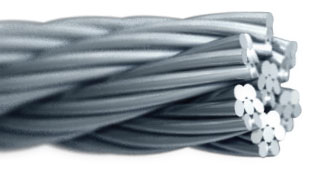
PT Duct & Grouting Systems
The purpose of grouting is to provide permanent protection to the post-tensioned steel confronting corrosion and to develop a bond betwixt the Prestressing cables and the surrounding structural concrete. Grouting shall be carried out as early as possible, but more often than not not after than 2 weeks of stressing. Whenever this stipulation cannot exist completed with for unavoidable reasons adequate temporary protection of the cables confronting corrosion by methods or products, which will non impair the ultimate adherence of the injected grout shall be ensured till grouting. Different equipment includes- Grout Mixer Mechanical type, Grout Pump, Grout Screen, Connection and air vents, Generator etc.
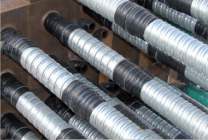
Monostrand PT systems
Monostrand PT systems tin be used as an economic method in not-corrosive environments. Some applications include indoor residential or office areas. To provide a price-effective system, the anchorage devices are non encased in an extruded jacket and plastic sleeves/grease caps are not included. However, our regular system still includes steel tendons with the special corrosion-inhibitor inside our distinctive green plastic sheathing.
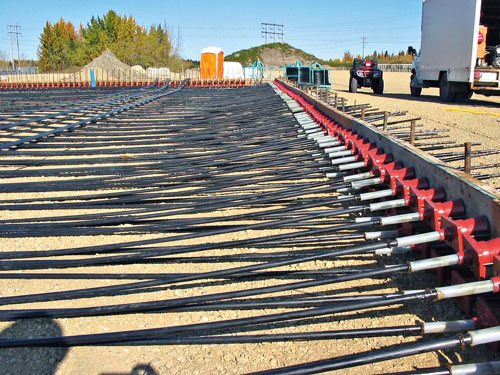
Multi-Strand system
Multistrand system comprises iii to 50-five strands (either 12.vii or 15.2mm diameter), round duct and anchorages. Prestressing forcefulness is applied to the tendons later the casting and curing of the surrounding concrete. All strands are stressed simultaneously using a hydraulic jack and are fastened at the live stop by wedge grips. The free infinite within the duct is then pressure level-filled with cement grout.
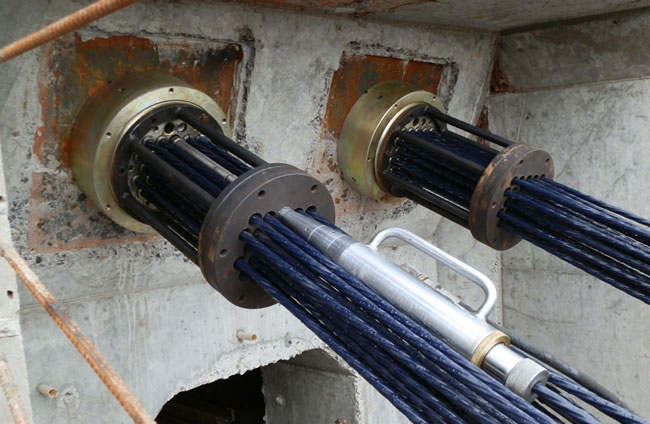
Vacuum-assisted grouting for bonded PT repair
Earlier grouting, a vacuum chest is used to pump the air in the prestressed channel to make the vacuum in the channel more than than 80%. Then the squeegee is used at the other end of the aqueduct. A positive pressure greater than 0.seven MPa presses the cement slurry into the prestressed tunnel. Because there are only a few air holes in the channel, it is difficult to form bubbles; at the same time, due to the positive and negative pressure difference between the aqueduct and the duster, the plumpness and density of the hole paddle are greatly improved. Vacuum-assisted grouting for bonded PT repair.
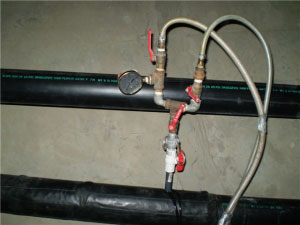
Conclusion
It is of import to take the opinion of practiced guidance for post-tensioning. It is a very important and complicated process. In that location are various services offered by different companies such equally External PT for Span girders & Slabs, Floor System and Suitable Arrangement for Slab and many more others. So cull the com[pny that fits your requirement.
Source – Tmgglobals, reaerchgate, bbrnetwork, dsiamerica,.dywidag-systems, posttensioning.co.nz
Source: https://www.constrofacilitator.com/post-tensioning-system-for-repair-and-rehabilitation/
Posted by: gibbonshising.blogspot.com


0 Response to "How Ro Repair Caps On Post Tension Slab"
Post a Comment